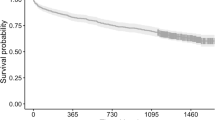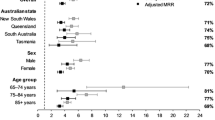Abstract
Summary
Mortality risk declined over time. Patients with fragility hip fracture experienced an approximate ninefold excess mortality, peaking shortly after fracture, in comparison with that of the general population. Continuous efforts in lowering the occurrence of hip fracture have the potential to improve the survival of the elderly population in China.
Purpose
Hip fractures in older adults often lead to an elevated risk of death. However, few studies investigated mortality risk following hip fracture in mainland China. This retrospective cohort study aimed to evaluate the crude mortality and excess mortality after fragility hip fractures in Lishui residents aged 50 years and older.
Methods
Patients having a fragility hip fracture between October 2013 and August 2019 were identified from the Lishui District Inpatient Data Collection and followed up until August 2020. Death information was ascertained from the linked death registry records. We calculated the follow-up mortality rate and corresponding 95% confidence intervals (CIs) as well as the standard mortality ratios (SMRs) in comparison with the mortality rates of Lishui residents.
Results
During the study period, a total of 808 patients (63.4% females) with an average age of 75 years were admitted for fragility hip fractures. The 1st, 2nd, and 3rd year follow-up mortality rates were 16.51, 6.06, and 5.03 per 100 person-year, respectively. The SMRs were 8.46 (6.94, 9.97), 5.74 (4.86, 6.63), and 4.63 (3.98, 5.27) for the 1st, 2nd, and 3rd year following fragility hip fracture.
Conclusion
Although mortality risk declined over time, patients with fragility hip fracture experienced an approximate ninefold excess mortality, peaking shortly after fracture, in comparison with that of the general population. Continuous efforts in lowering the occurrence of hip fracture have the potential to improve the survival of the elderly population in China.


Similar content being viewed by others
Data availability
The datasets generated during and/or analyzed during the current study are not publicly available due to restrictions to the availability of these data.
References
World Health Organization (2022) International day of older persons - 1 October 2022. Available at: https://www.who.int/srilanka/news/detail/01-10-2022-international-day-of-older-persons---1-october-2022. Accessed 26 October 2022.
Rupp M, Walter N, Pfeifer C et al (2021) The incidence of fractures among the adult population of Germany–an analysis from 2009 through 2019. Dtsch Arztebl Int 118:665–669
Clynes MA, Harvey NC, Curtis EM, Fuggle NR, Dennison EM, Cooper C (2020) The epidemiology of osteoporosis. Br Med Bull 133:105–117
Johnell O, Kanis JA (2006) An estimate of the worldwide prevalence and disability associated with osteoporotic fractures. Osteoporos Int 17:1726–1733
Tajeu GS, Delzell E, Smith W et al (2014) Death, debility, and destitution following hip fracture. J Gerontol A Biol Sci Med Sci 69:346–353
Yoon HK, Park C, Jang S et al (2011) Incidence and mortality following hip fracture in Korea. J Korean Med Sci 26:1087–1092
Wang CB, Lin CF, Liang WM et al (2013) Excess mortality after hip fracture among the elderly in Taiwan: a nationwide population-based cohort study. Bone 56:147–153
Koh GH, Tai BC, Ang LW et al (2013) All-cause and cause-specific mortality after hip fracture among Chinese women and men. Osteoporos Int 24:1981–1989
National Bureau of Statistics (2021) The seventh national population census. Available at: http://www.stats.gov.cn/tjsj/zxfb/202105/t20210510_1817176.html. Accessed 2 July 2021.
Zeng Q, Li N, Wang Q et al (2019) The prevalence of osteoporosis in China, a nationwide, multicenter DXA survey. J Bone Miner Res 34:1789–1797
Zhang C, Feng J, Wang S et al (2020) Incidence of and trends in hip fracture among adults in urban China: a nationwide retrospective cohort study. PLoS Med 17:e1003180
Baidu Wikipedia (2022) Lishui District. Baidu Wikipedia website. Available at: https://baike.baidu.com. Accessed 26 October 2022.
Chen Y, Jiao Z, Chen P, Fan L, Zhou X, Pu Y et al (2021) Short-term effect of fine particulate matter and ozone on non-accidental mortality and respiratory mortality in Lishui district. China BMC Public Health 21:1661
Toson B, Harvey LA, Close JC (2015) The ICD-10 Charlson Comorbidity Index predicted mortality but not resource utilization following hip fracture. J Clin Epidemiol 68:44–51
Rossen LM, Ahmad FB, Anderson RN et al (2021) Disparities in excess mortality associated with COVID-19 - United States, 2020. MMWR Morb Mortal Wkly Rep 70:1114–1119
Bischoff HA, Stähelin HB, Dick W et al (2003) Effects of vitamin D and calcium supplementation on falls: a randomized controlled trial. J Bone Miner Res 18:343–351
Kim KM, Choi HS, Choi MJ, Chung HY (2015) Calcium and vitamin D supplementations: 2015 position statement of the Korean Society for Bone and Mineral Research. J Bone Metab 22:143–149
Lappe J, Cullen D, Haynatzki G, Recker R, Ahlf R, Thompson K (2008) Calcium and vitamin d supplementation decreases incidence of stress fractures in female navy recruits. J Bone Miner Res 23:741–749
Aibar-Almazán A, Voltes-Martínez A, Castellote-Caballero Y, Afanador-Restrepo DF, Carcelén-Fraile MDC, López-Ruiz E (2022) Current status of the diagnosis and management of osteoporosis. Int J Mol Sci 23:9465
Ip TP, Leung J, Kung AW (2010) Management of osteoporosis in patients hospitalized for hip fractures. Osteoporos Int 21:S605–S614
Wang PW, Yao XD, Zhuang HF et al (2022) Mortality and related risk factors of fragile hip fracture. Orthop Surg 14:2462–2469
Chakhtoura M, Dagher H, Sharara S et al (2021) Systematic review of major osteoporotic fracture to hip fracture incidence rate ratios worldwide: implications for Fracture Risk Assessment Tool (FRAX)-derived estimates. J Bone Miner Res 36:1942–1956
Yong EL, Ganesan G, Kramer MS, Howe TS, Koh JSB, Thu WP et al (2020) Risk factors and trends associated with mortality among adults with hip fracture in Singapore. JAMA Netw Open 3:e1919706
Yoo JI, Kim HY, Jang S, Lee YK, Ha YC (2020) Risk factors for subsequent hip fractures and fatality after an initial hip fracture in Korea: using nationwide claims data. Arch Osteoporos 15:165
ESHRE Capri Workshop Group (2016) The influence of social factors on gender health. Hum Reprod 31:1631–1637
Merzel C (2000) Gender differences in health care access indicators in an urban, low-income community. Am J Public Health 90:909–916
Mustard CA, Kaufert P, Kozyrskyj A, Mayer T (1998) Sex differences in the use of health care services. N Engl J Med 338:1678–1683
McLaughlin D, Vagenas D, Pachana NA, Begum N, Dobson A (2010) Gender differences in social network size and satisfaction in adults in their 70s. J Health Psychol 15:671–679
Lau ES, Paniagua SM, Guseh JS et al (2019) Sex differences in circulating biomarkers of cardiovascular disease. J Am Coll Cardiol 74:1543–1553
School of Public Health of Southeast University, Health Committee in Lishui District, Statistics Bureau in Lishui District et al (2020) Lishui Whitebook. Nanjing, China.
Tosteson AN, Gottlieb DJ, Radley DC et al (2007) Excess mortality following hip fracture: the role of underlying health status. Osteoporos Int 18:1463–1472
Li S, Sun T, Liu Z (2016) Excess mortality of 1 year in elderly hip fracture patients compared with the general population in Beijing. China Arch Osteoporos 11:35
Tsuboi M, Hasegawa Y, Suzuki S et al (2007) Mortality and mobility after hip fracture in Japan: a ten-year follow-up. J Bone Joint Surg Br 89:461–466
Wakasugi M, Kazama JJ, Wada A, Hamano T, Masakane I, Narita I (2020) Long-term excess mortality after hip fracture in hemodialysis patients: a nationwide cohort study in Japan. J Bone Miner Metab 38:718–729
Hoogendijk EO, Afilalo J, Ensrud KE, Kowal P, Onder G, Fried LP (2019) Frailty: implications for clinical practice and public health. Lancet 394:1365–1375
Wang O, Hu Y, Gong S et al (2015) A survey of outcomes and management of patients post fragility fractures in China. Osteoporos Int 26:2631–2640
Chen M, Du Y, Tang W, Yu W, Li H, Zheng S, Cheng Q (2022) Risk factors of mortality and second fracture after elderly hip fracture surgery in Shanghai, China. J Bone Miner Metab 40:951–959
Acknowledgements
We thank the project team from the Lishui Renmin Hospital, Lishui Health Commission of Lishui, in particular for study coordination and data collection, data processing, and data management. Hua Y contributed to the data analysis, results interpretation, and manuscript preparation and revision. Du W, Fan L, Zhou J, Moayyeri A, and Libanati C conceived the study and contributed to the results interpretation, critical review, and manuscript revision. All authors contributed to the critical review, results interpretation, and manuscript revision, and approved the final manuscript as submitted.
Funding
This study was supported by the Fundamental Research Funds for the Central Universities (No.3225002002A1), Department of Education (No.1125000172), the National Natural Science Foundation of China (Grant Number: 71704192, 82173899), and UCB Biopharma.
Author information
Authors and Affiliations
Corresponding author
Ethics declarations
Conflicts of interest
Zhou J, Moayyeri A, and Libanati C are current employees of UCB Biopharma and may hold/have access to stock options. Hua Y, Li Y, Fan L, Huang F, Wu Z, Xue H, Yang B, Chen P, Rui Y, Tian Y, and Du W declare that they have no conflict of interest.
Additional information
Publisher's note
Springer Nature remains neutral with regard to jurisdictional claims in published maps and institutional affiliations.
Supplementary Information
Below is the link to the electronic supplementary material.
Rights and permissions
Springer Nature or its licensor (e.g. a society or other partner) holds exclusive rights to this article under a publishing agreement with the author(s) or other rightsholder(s); author self-archiving of the accepted manuscript version of this article is solely governed by the terms of such publishing agreement and applicable law.
About this article
Cite this article
Hua, Y., Li, Y., Zhou, J. et al. Mortality following fragility hip fracture in China: a record linkage study. Arch Osteoporos 18, 105 (2023). https://doi.org/10.1007/s11657-023-01304-z
Received:
Accepted:
Published:
DOI: https://doi.org/10.1007/s11657-023-01304-z




